The Warsaw Ghetto was a valiant uprising.
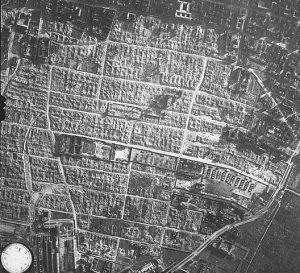
Nicklaus Bobertz is a professional historian who runs, writes, and owns a history website called The History Ace that aims to provide easy answers to hard history questions.
Imagine if you will between 375,000-400,000 people crammed into a space that is smaller than a modern airport. At its peak, the Warsaw Jewish ghetto housed around 30% of the total population of the city of Warsaw while only constituting 2% of the city’s land mass. Surviving for 3 years from 1940-1943 the Warsaw ghetto would be destroyed after a massive revolt against Nazi deportations to the death camps of Treblinka, Majdanek, Trawniki, and Poniatowa.
This article goes over how the population of the Warsaw Ghetto planned and revolted against Nazi deportations in the winter of 1943 along with how the Nazis ultimately destroyed the Warsaw ghetto, replacing it with the Warsaw concentration camp.
Much of what we know about the Warsaw ghetto uprising and destruction comes from first-hand accounts from the survivors along with a handful of primary sources such as German photographs, the surviving portion of the Ringelblum Archive, and Nazi records.
Here is the story of the uprising of the Warsaw ghetto and its destruction.
Warsaw Ghetto – Beginning of the Jewish Underground Uprising in Warsaw
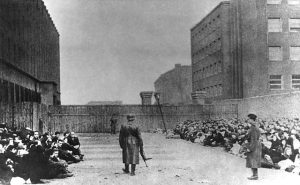
By Nieznany/unknown – Warszawskie getto 1943−1988. W 45 rocznicę powstania, Wydawnictwo Interpress, Warszawa 1988, ISBN 83-223-2465-0 (photographs at the end of the book; pages not numbered), Public Domain
After the fall of France in 1940, the Nazi government of Germany began to look for an answer to the “Jewish” question. Several plans such as relocating the Jewish population to Madagascar were proposed but sometime in late 1941 the Nazi regime agreed to enact their plan called di Endlösung or the “final solution.”
This solution was the creation of several death camps around German-held eastern Europe where large populations of undesirable people were executed. In the summer of 1942 Nazi SS troops began to round up the population of the Warsaw ghetto. From July through September of 1942 around 250,000 people were deported out of the Ghetto of Warsaw, a vast majority being Jewish.
The Nazi SS acted under the guise of relocating the inhabitants of the overcrowded Ghetto. People would be rounded up and told they are moving to a better ghetto with more room only to be loaded onto a cattle train cart and sent 80 km away to the Treblinka death camp.
It did not take long for the Jewish population of the Warsaw ghetto to begin to realize what was going on. For nearly two years a secret underground network of smugglers had been developing to bring in outside medical equipment and food ratios to feed the starving ghetto community. This smuggler network also brought news of the fate of those who left the ghetto.
In early October of 1942 the Jewish Combat Organisation was formed in the Warsaw Ghetto and started to recruit in an effort to stop forced deportations. Over the next coming months, this organization would begin to smuggle in weapons and medical rations to prepare to resist further deportations.
Warsaw Ghetto – The Uprising and Revolt in the Winter of 1942
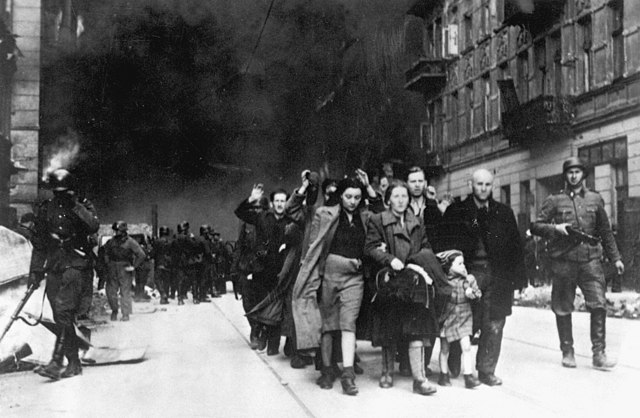
By Unknown author (Franz Konrad confessed to taking some of the photographs, the rest was probably taken by photographers from Propaganda Kompanie nr 689.[1][2]) – http://narademo.umiacs.umd.edu/cgi-bin/isadg/viewobject.pl?object=77260, Public Domain
On January 18th of 1943 Nazi SS troops again entered the Warsaw ghetto to resume the deportations. Over the first couple hours of this Nazi operation, there was little resistance as over 5,000 people were rounded up and 600 were killed from resisting. However, unlike the previous Summer now the population of the Warsaw ghetto was armed and had two volunteer militia; the Jewish Combat Organisation (ŻOB) and the Jewish Military Union (ŻZW).
In the afternoon of January 18th, 1943 the Nazi SS troops encountered Jewish fighters armed with smuggled handguns and Molotov cocktails. This initial resistance in January of 1942 was successful in driving the SS troops out of the Warsaw ghetto and led to the Polish underground supporting the resistance.
The January revolt in the Warsaw ghetto caused the SS troops to retreat and form a strategy on how to deal with the armed militia in the Ghetto. From January 18th up until April 19th, 1943 the Warsaw Ghetto was controlled by the ŻZW and ŻOB. During this time both of these groups created fighting posts and began to fortify their positions against an inevitable German attack.
On April 19th, 1943 SS troops again entered the Warsaw ghetto to resume the deportations and quell the revolt. They were met with a hail of gunfire, Molotov cocktails, and now hand grenades smuggled into the ghetto. German light tanks were caught on fire as they advanced into the ghetto.
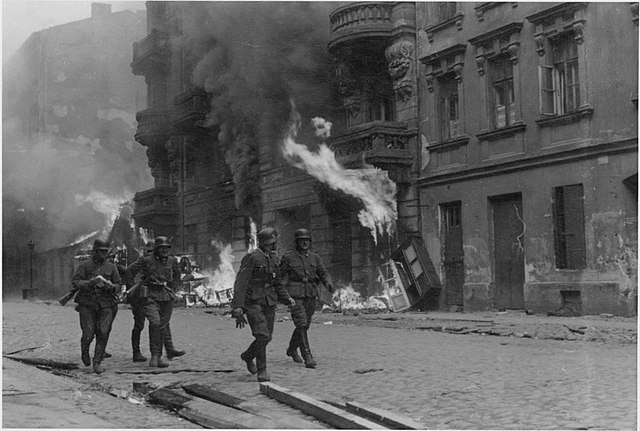
Stroop Report 2/4.Record Group 038.United States Counsel for the Prosecution of Axis Criminality; United States Exhibits, 1933-46.HMS Asset Id: HF1-88454435.ReDiscovery Number: 06315
Over the next 10 days, the Warsaw Ghetto was a battlefield. The German troops swept from street to street burning out every building with flamethrowers. Slowly over the next 10 days each street of the ghetto was cleared by the German SS who encountered heavy fighting. On April 29th a portion of the remaining fighters managed to escape through a makeshift tunnel.
By May 16th, 1943 the Warsaw Ghetto uprising was subdued, and in a symbolic gesture when SS commander Jurgen Stroop ordered the destruction of the Great Synagogue of Warsaw. This was the start of the destruction of the Warsaw Ghetto.
Himler Orders The Complete Destruction of The Warsaw Ghetto
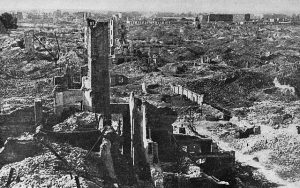
By Nieznany/unknown – Warschau. Poznan. Gdansk. Wroclaw. Stalinogrod, Sondernummer der Wochenschrift “Stolica”/Wydawnictwo “Stolica”, Warschau Juni 1954/Warszawa czerwiec 1954, p. 39 (publikacja w języku niemieckim/publication in German language), Public Domain
After the uprising of the Warsaw Ghetto in 1943 much of the ghetto was completely destroyed by the combat. The few buildings left standing were on the Aryan side of the ghetto and left unscathed.
On General Jurgen Stroop’s orders, several accounts of the battle were created as souvenirs for upper-ranking German politicians. Four accounts of the Warsaw Uprising were created. The first was for Stroop himself to serve as a war memento. The second was for Freidrich Kruger the SS commander of German-occupied Poland. The third was for Heinrich Himmler the commander of the German SS. The fourth was intended for Hitler but was unable to reach him; it does not survive or has not been located.
After Heinrich Himmler received his copy of the Stroop Report he was convinced that the Warsaw ghetto should be completely destroyed and turned into a concentration camp. More so the task of removing the rubble, flattening the land, and creating the concentration camp itself would be given to the surviving members of the Warsaw Ghetto.
Over the next months, a portion of the rubble of the Warsaw Ghetto was cleared to make way for the upcoming Warsaw Concentration camp. This concentration camp was designed for hard labor and a majority of the prisoners of the camp were Jewish men under the age of 40 who could handle extremely hard forced labor.
The task of these prisoners was to clear the 3 square kilometers of rubble, flatten the terrain, and convert the final land mass into a park as envisioned by Himler. While clearing the debris and destroying the remaining parts of the Warsaw Ghetto the prisoners were ordered to set aside any jewelry, metal, and other objects which could either finance or supply the German war machine.
Over the next year and a half, the remaining Jewish prisoners worked in this Warsaw concentration camp clearing the rubble of the Warsaw Ghetto. By the time the Soviet Red Army reached Warsaw on January 17th, 1945 only 200 Jewish prisoners remained.
Conclusion
The Warsaw Ghetto is a fascinating piece of history that many people do not know about. It was the largest ghetto by population size in Nazi Germany and was the site of one of the largest revolts against Nazi rule.
Today not much is left of the ghetto itself. It was leveled by an uprising and then dismantled by the survivors in a concentration camp. However, recent work in Warsaw has seen the creation of statues around the city that marked the boundaries of the ghetto. When you visit the city today make sure you walk around downtown; you will encounter some of these statues along with stories of the people who called the ghetto home.
Cite This Article
"Warsaw Ghetto: Its Resistance and Eventual Destruction" History on the Net© 2000-2024, Salem Media.
July 27, 2024 <https://www.historyonthenet.com/warsaw-ghetto-its-resistance-and-eventual-destruction>
More Citation Information.





